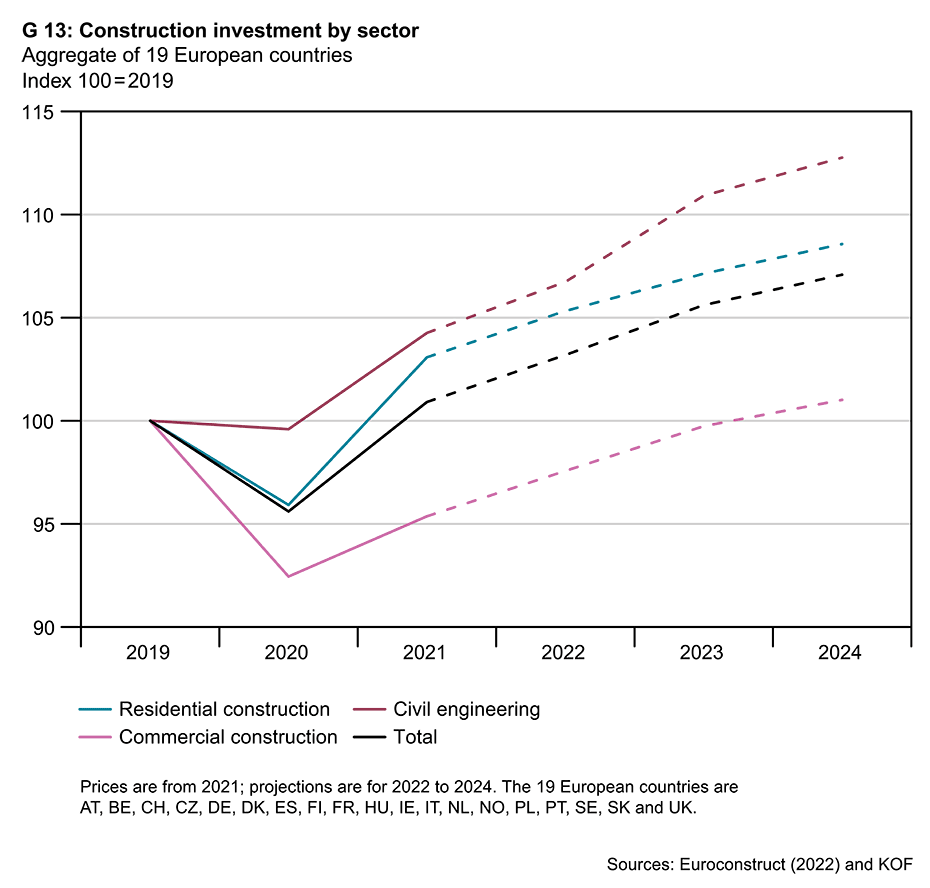
An economic stimulus package is set to boost Europe’s civil engineering sector
An economic stimulus package launched by the EU Commission is intended to revive Europe’s economy in the wake of the COVID-19 pandemic and, at the same time, modernise its infrastructure. But acute problems in the construction market as well as local planning restrictions could reduce the programme’s impact.
Roads, tunnels, bridges, railway lines, water supplies and electric cable networks: they all serve the entire population. Not only do such civil engineering projects improve people’s quality of life, they are also crucial for economic growth. That is why most of them are publicly funded. However, this key role played by the state means that the civil engineering market follows different rules than residential or commercial construction, which are largely privately financed.
The 19 European countries1 that are members of Euroconstruct – the independent network for construction market forecasts (see box) – invested a total of 400 billion euros in civil engineering projects in 2021. By way of comparison, this investment is equivalent to Austria’s entire gross domestic product. Although the European civil engineering market is only half the size of the residential construction market, it has recently grown more strongly and, in particular, more stably. While investment in the construction industry shrank by around 6 per cent in 2020, the European civil engineering sector defied the COVID-19 pandemic and attracted only slightly lower investment than it had the previous year (see chart G 13).
Robust civil engineering sector
The resilience of the civil engineering sector can be explained, firstly, by the long-term nature of infrastructure projects. After all, major projects that had been planned for many years and had already been awarded as part of the public procurement system were continued despite the COVID-19 pandemic. This situation was also helped by the fact that these projects were often outdoor construction sites, where the risk of infection with coronavirus was lower.
And, secondly, such infrastructure investment in both the EU and Switzerland is financed to a significant extent by earmarked infrastructure funds in addition to the EU budget and national budgets. This earmarked funding decouples civil engineering investment from so-called discretionary fiscal policy measures that specifically affect the performance of the economy, thereby ensuring consistently stable investment.
EU economic stimulus package creating new impetus
The Next Generation EU (NGEU) programme – a massive economic stimulus package initiated by the European Commission – is now bringing new impetus to the construction sector throughout the EU. This temporary stimulus instrument was launched in February 2021 to boost socio-economic recovery in the wake of the COVID-19 pandemic. The 807 billion euro2 budget will fund EU member states’ reform investment that promotes sustainability, digitalisation and resilience between 2020 and 2023. This is additional funding amounting to two-thirds of the regular EU budget that will flow into the economy – partly into the construction sector – as a result of this programme.
In order to achieve the climate targets set by the European Commission, the NGEU programme places great emphasis on the transition to carbon neutrality. The construction sector also has an important role to play here. This is because the financial stimulus package is intended to modernise the building stock in terms of energy efficiency, to expand the rail transport networks and ensure that they are state of the art, and to push ahead with sustainable energy generation plants. The EU countries’ reform and investment plans stipulate that around 40 per cent of the requested funds will be invested in the green transformation. Depending on a country’s development plan, a considerable portion of this is likely to flow into construction investment.
So what stimulus can the NGEU funds be expected to provide to Europe’s civil engineering sector? According to Euroconstruct’s assessment, civil engineering in Italy and Spain should benefit especially from these additional financial resources because these two particularly struggling sectors are among the main beneficiaries of the NGEU subsidy pot, with external pagejust under 70 billion euros awarded3 to each of them (338 billion euros4). Euroconstruct forecasts that civil engineering investment will grow by 22 per cent overall in Spain and by 18 per cent in Italy over the period from 2021 to 2024. This substantial growth potential is also due to the recent below-average performance of these two civil engineering sectors.
Adversity diminishes the potential benefits
However, these forecasts are subject to considerable uncertainty. There are several obstacles to fully utilising the financial opportunities available. Firstly, political and bureaucratic hurdles are already evident. In Italy, for example, a large proportion of the funding is allocated to the municipalities. However, the projects and investment sums involved are so huge and the time horizon granted is so short that it becomes difficult for smaller administrative units to muster the necessary planning capacities. Bureaucratic processes in Spain are already slowing the progress of the first few projects to be launched and, at the same time, there is criticism about transparency.
Secondly, the currently extremely challenging market conditions are weakening the programme’s impact. The sharp rise in the cost of construction materials and energy prices across Europe as well as shortages of materials and labour are hampering construction activity. This increases uncertainty, which makes the planning of long-term infrastructure projects more difficult. Moreover, construction price inflation reduces the amount of effective construction output that can be financed using the funds.
One thing is clear: the NGEU stimulus package – in addition to the financial resources from the regular EU budget and the national budgets – will drive the further expansion and modernisation of European infrastructure. However, the impact of the stimulus on Europe’s civil engineering investment is likely to be diminished by the challenging operating environment.
-----------------------------------
1 Definition of 'EC19' according to Euroconstruct (see box): Austria, Belgium, Czech Republic, Denmark, Finland, France, Germany, Hungary, Ireland, Italy, Netherlands, Norway, Poland, Portugal, Slovakia, Spain, Sweden, Switzerland and United Kingdom
2 At current prices.
3 Around 385 billion euros constitutes loans
4 At current prices in each case.
Euroconstruct – a network for construction forecasts
Euroconstruct is the leading network for construction forecasts in the European market. Research institutes from 19 countries across Europe, including KOF, produce semi-annual reports on the performance of the construction industry with a regional and sectoral focus. This collaboration mainly serves to harmonise indicators and forecasts within the European construction market. The latest publication is presented at the Euroconstruct conference, a platform for all players in the European construction industry. This article was published in the magazine Die Volkswirtschaft in September.
Contact
KOF FB Konjunkturumfragen
Leonhardstrasse 21
8092
Zürich
Switzerland

